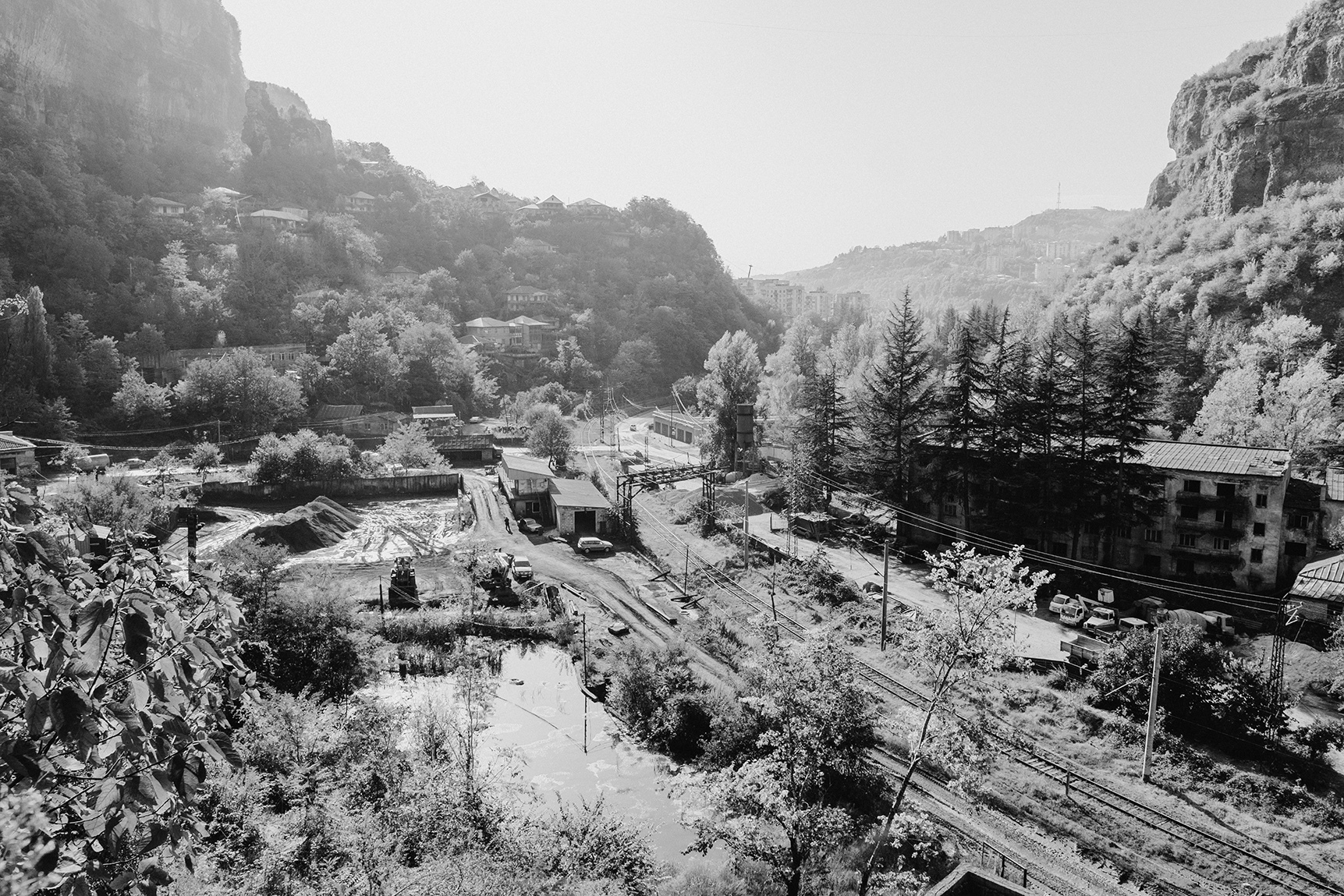Chiatura: Black Gold, Quiet Collapse
Chiatura was carved by the mines and built on manganese. A century of digging has left Chiatura scarred, sick, and silenced. Now, with operations halted and voices rising, the town demands more than justice: it demands a future

Chiatura-oro-nero-silenzio-grigio
Chiatura - © Alberto Canci
Before delving into the recent protests and economic upheaval in Chiatura, it is essential to understand the complex historical and social background that has shaped this unique mining town in central Georgia.
Chiatura is not merely a site of industrial activity, it is a place where the landscape, the people, and the local identity have been profoundly molded by over a century of extractive activities.
Nestled in a deep valley carved by the Qvirila River, Chiatura developed around one of the richest manganese deposits in the world. By the early 20th century, the town supplied more than half of global manganese demand.
This mineral, vital for producing steel and now increasingly important for renewable technologies like wind turbines and electric vehicle batteries, has long dictated the region’s economic and social trajectory.
During the Soviet era, Chiatura thrived as a model of extractive industrialism. Its infrastructure, from the iconic Soviet-era cable cars to vast processing plants, was designed not for urban comfort, but to maximize mining efficiency. The town’s layout, and even its collective psyche, came to revolve around the rhythms of extraction and export.
Yet this productivity came at a cost. Chronic exposure to manganese dust has left a heavy legacy of neurological and respiratory illnesses. Today, many older residents suffer from symptoms reminiscent of Parkinson’s disease, brought by chronic exposure to excessive manganese levels.
Environmental degradation is visible at every turn: the river that runs through Chiatura is darkened with sediment, hillsides are gouged by years of blasting and tunneling, and entire villages such as Itkhvisi and Shukruti have suffered partial collapse due to unstable ground caused by reckless underground operations.
Following the collapse of the Soviet Union, Chiatura’s population shrank dramatically, from around 30,000 to less than half that today. In the ensuing chaos of privatization, Georgian Manganese (now operated by a series of opaque holding companies, including ties to Ukrainian oligarch Igor Kolomoisky) took over operations.
The company, while promising modernization and development, was soon accused of exploiting workers, polluting the environment, and evading responsibility for infrastructure failures. Labor protections were weak, and fatal accidents and health hazards were frequently underreported or ignored.
The physical and symbolic center of Chiatura remains its cable car system, once free to miners and now updated for public use. These “flying coffins” (as they were once known) symbolize both the ingenuity and decay of a place suspended, literally and metaphorically, between past and present.
Despite all this, there are glimpses of resilience. Locals speak with pride of Chiatura’s role in industrial history and dream of a different future, one built on tourism, cultural preservation, and environmental restoration.
Some advocate for a reconnection with Chiatura’s ancient and religious heritage, pointing to landmarks like the Mghvimevi Monastery and the Katskhi Pillar. Others seek to reposition the town as a site of “dark tourism”, appealing to those drawn to post-industrial ruins and Soviet nostalgia.
What unites these visions is a shared desire to end Chiatura’s long-standing dependence on a single, extractive industry. Or, at the very least, to reimagine it in a way that is fairer, safer, and more sustainable.
Yet even now, with mining operations halted and manganese no longer leaving the valley, the tension between survival and exploitation remains unresolved.
The local economy is still almost entirely tied to this resource, and for thousands of families the mine represents the only foreseeable future.
In this light, the current protests are not merely a reaction to unpaid wages or broken promises: they are a desperate cry to preserve the right to work, to live with dignity, and to be part of shaping a future for Chiatura. This is not just a town in crisis: it is a town whose very identity has been forged — and now placed at risk — by the metal beneath its soil.
The last protests
A long-simmering labor and environmental crisis reached boiling point over the course of late 2024 and early 2025, culminating in mass layoffs, widespread protests, and an ongoing social upheaval.
The situation unfolded decisivelyin November 2024, when Georgian Manganese, a key economic player in the region and operator of Chiatura’s manganese mines, announced a four-month suspension of operations.
Citing a sharp drop in global ferroalloy prices and continuous local protests, the company offered workers 60% of their salaries and insurance coverage during the shutdown. However, this move sparked immediate concern among the up to 5,000 employees in Chiatura and nearby Zestaponi, many of whom are heavily indebted and rely entirely on mining income.
The situation was further inflamed by longstanding protests from residents of Shukruti, a village near Chiatura. These villagers accused Georgian Manganese of destroying their homes and orchards through unsustainable mining practices, for which they claimed to have received no compensation. Although a local court banned protests near mining sites in August 2024, blockades persisted, contributing to a dramatic decline in ore extraction.
By March 2025, with operations still suspended and workers reporting they had not received the promised partial wages, thousands took to the streets. Georgian Manganese’s contractor, the Chiatura Management Company (CMC), declared that it would not resume underground mining at all, citing financial unviability confirmed by an audit from German firm DMT.
The company claimed to have lost over ₾83 million in loans used to pay salaries during the shutdown. Concurrently, the Revenue Service imposed a tax lien, revealing debts in the tens of millions of Georgian lari.
Demands quickly escalated from salary payments to full nationalization of the mining industry. On March 7, 2025, the CMC declared bankruptcy, laying off 3,500 workers, effectively leaving the town economically paralyzed. Prime Minister Irakli Kobakhidze acknowledged the crisis but dismissed nationalization as “fundamentally wrong” despite the fact that Georgian Manganese had been under state-appointed special management since 2017.
Protests intensified throughout March, with daily demonstrations and calls for direct government intervention. A tripartite commission involving state, employer, and union representatives was formed, but no miner representatives were included, deepening mistrust. Meanwhile, residents of Chiatura, led by both miners and local activists, maintained pickets and blockades to prevent the export of manganese, demanding that their plight be addressed.
In late April, the CMC announced plans to restart operations through a “reorganisation” process, involving both technical upgrades and personnel reshuffling. A Russian national, Mikhail Sotski, was appointed to oversee the revival.
However, this move only heightened tensions: miners denounced the plan for potentially reinstating just 200 out of thousands of laid-off workers, while offering no clarity on reemployment guarantees or conditions.
By April 28, protests had grown even more combative, with six miners beginning hunger strikes and a large demonstration announced for May 1.
Days later, violence broke out when four protesters were arrested for allegedly assaulting a mine director. The charges were soon escalated to “group violence” with potential prison sentences of up to nine years, intensifying the already volatile atmosphere.
As of June 2025, Chiatura remains gripped by economic uncertainty and social unrest. The miners continue to demand state intervention, compensation for lost wages, and a say in the region’s industrial future.
What began as a labor dispute has grown into a broader crisis emblematic of deeper failures in governance, environmental accountability, and corporate responsibility in Georgia’s resource-dependent towns.
Pictures – © Alberto Canci
Tag:











